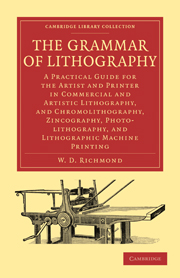 The Grammar of Lithography
The Grammar of Lithography CHAPTER III - Importance of a proper choice of paper
Published online by Cambridge University Press: 05 July 2011
Summary
Intimately connected with the subject of Machine Printing, is that of the proper qualities and descriptions of paper to be used, and we may advantageously devote a few paragraphs to it. We may say at the outset, that it is to be regretted that clerks and travellers who take orders for printing do not make themselves better acquainted with the fitness of papers for the various kinds of work. The proper choice of paper in many instances makes all the difference between good and bad printing, and a suggestion from the person who is taking the order would, we think, be generally favourably entertained.
18. Writing, drawing, loan, or other hard-made English-sized papers should never be used for printing upon when beauty of impression is the chief consideration. The use of such papers should be restricted to note, letter, and invoice headings and other similar work, in which the appearance of the printing is secondary to its use for writing upon. Foreign and common English writing-papers are sized less hardly, and take a better impression than the superior makes.
19. To produce the best printing, the paper must be somewhat absorbent, and that is the well-known character of printing and plate papers, the latter being still less sized than the former. If a good printing paper be well glazed, it will resemble writing-paper sufficiently to be used for circulars and such-like work, and will take a much better impression than can be got upon the harder-sized material; while it will bear writing upon well enough for all ordinary purposes of adding names, prices, &c.
- Type
- Chapter
- Information
- The Grammar of LithographyA Practical Guide for the Artist and Printer in Commercial and Artistic Lithography, and Chromolithography, Zincography, Photo-lithography, and Lithographic Machine Printing, pp. 236 - 242Publisher: Cambridge University PressPrint publication year: 2010First published in: 1878


